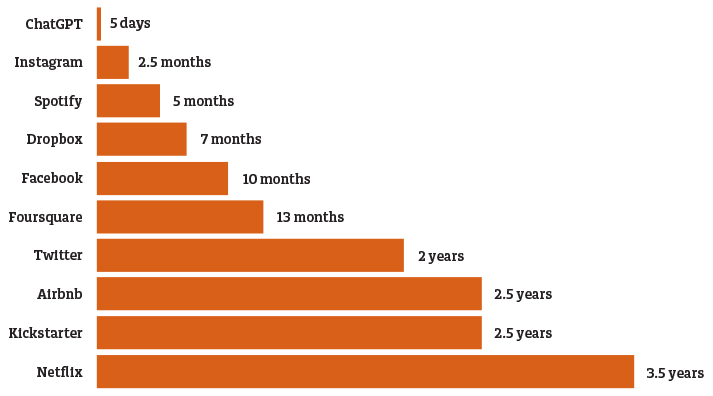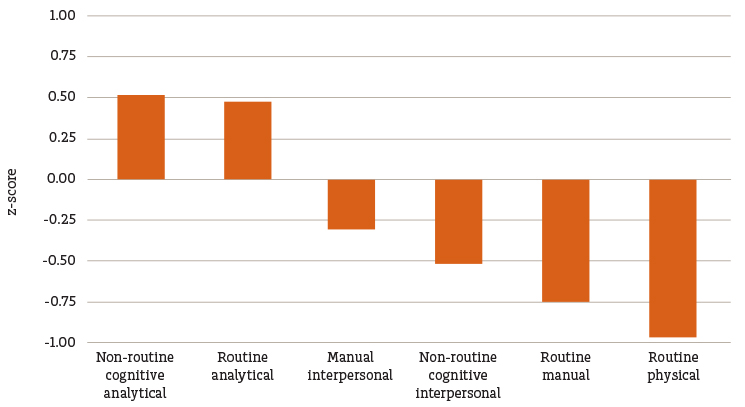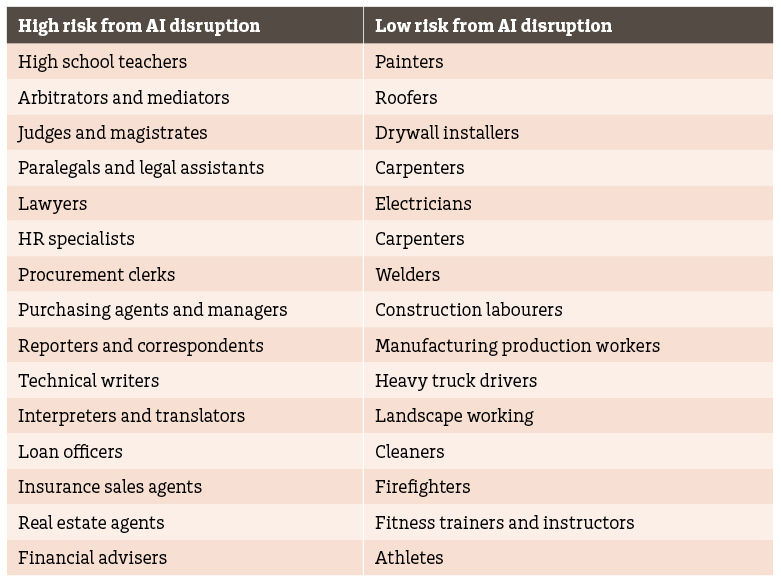What’s going on with AI?
Disruptive technologies’ emergence tends to create even wider than usual divisions between those with glass half full inclinations and those who view life as a glass half empty.
The advent of artificial intelligence (AI) has widened the divide with optimists imagining productivity gains, the creation of new industries, and better lives for all. Pessimists envisage societal dislocations, perhaps even apocalyptic consequences akin to Hollywood science fiction.
While AI in various forms has been around for more than 50 years, the 2022 release of OpenAI’s ChatGPT catalysed the next leg of interest and commercialisation captivating consumers to the point where the application reached one million users in under a week, the fastest adoption of an online application to date (Chart 1).
Chart 1: ChatGPT reached one million users faster than any other online application
Amount of time to reach one million users for online applications

Source: Statista, with data from company announcements via Business Insider/LinkedIn, as of 24 January 2023. Kickstarter measured as one million backers, Airbnb measured as one million nights booked, Instagram measured as one million downloads.
It’s early days for the newest manifestations of AI and our thoughts are likewise preliminary.
Defining artificial intelligence
After that entrée, it may be useful to define the term “artificial intelligence” as it assumes a shared understanding of its meaning.
“In short, AI is the ability of a machine to perform cognitive functions typically associated with human minds, such as perceiving, reasoning, learning, interacting with the environment, and problem solving. Examples of AI technologies include robotics, autonomous vehicles, computer vision, language, virtual agents, and machine learning.”(1)
Now is also a good time to be reminded of a quote by Roy Amara, an American futurologist:
“We tend to overestimate the effect of a technology in the short run and underestimate the effect in the long run.”
There is abundant literature arguing that a very large part of the economy is likely to see AI integration and widespread employment dislocations, but it’s equally reasonable to assert that a good deal of what’s been voiced falls into the ‘guesstimate’ category.
AI has been held up as a game-changer akin to the Industrial Revolution, which represented a break from thousands of years of human history as life on the land gave way to urban living, and so much more.
A sober perspective would be to expect the most significant changes, and productivity gains showing up in a decade or two from now, because that’s been the trend with past innovations that benefit society. Unlocking the potential productivity benefits of the technology will require the reskilling of workforces and organisational and process innovation, both of which are historically slow-moving.
AI adoption, for now, appears to be greatest in a few pockets of the economy, like customer contact centres and software engineering, where it is particularly compelling as a productivity enhancer that can reduce labour costs.
Even so, we need to guard against over-egging potential productivity benefits because productivity growth data around computers and the internet shows that while productivity has been boosted, it has not been a massive boost and productivity growth reverted to around the 1970s–’80s pace after the late 1990s and early 2000s.
Knowledge workers to be most impacted
It’s easy to be overwhelmed by statistics and forecasts around the impact of AI so I’ll mention just a few.
One study suggests that in the United States, 60% of occupations and 80% of workers will be impacted by AI by 2040.(2) Moreover, rather than blue collar and physical work being most affected, it’s those engaged in knowledge work that are more vulnerable (Charts 2 and 3).
Chart 2: Knowledge workers are most at risk from AI
Occupation skills and generative AI exposure

Source: Generative AI and firm values by Andrea L Eisfeldt (UCLA) et al 2023. Note: AI exposures converted into standard z-score.
Chart 3: Some surprises around high risk of disruption and low risk of disruption jobs from AI

Source: How will language modelers like ChatGPT affect occupations and industries? Ed Felten (Princeton) Manav Raj (University of Pennsylvania) Robert Seamans (New York University)1 March 2023 taken from AI: winner takes most, Australia February 2024, TD Global Investment Solutions, TD Epoch
Perhaps one reason for this is that the productivity of physical work has risen impressively over multiple decades with coal miners’ productivity, for example, having climbed around 830% since 1949.(3)
It’s difficult to imagine white collar work being able to claim such productivity gains despite the adoption of technologies ranging from the personal computer in the 1980s to contemporary digital technologies.
However, rather than focusing so much on impacts on current jobs and industries, it’s likely that the bulk of the gains will come from new products and industries.
Think of how email, in the mid-1990s, replaced the fax machine, or the personal computer, in the 1980s, replaced physically storing receipts.
A takeaway from all this is that the best jobs to have will likely to be those that complement AI, while prospects for jobs that can be replaced, which are mainly cognitive based ones, are dimmer.
Ironically, less formal education might be the right move for finding or keeping a job in the future.
AI winners: incumbents to get stronger?
At this time, there are few pure play, publicly traded companies in the AI realm, and incumbents with their first mover advantages, existing networks of users and distribution, as well as proprietary data to train large language models, having fared well.
Recent market reactions have validated this view, as large cap technology stocks have outperformed smaller counterparts, suggesting many investors believe the incumbents are poised to capitalise on the first wave of AI adoption.
Capitalism is meant to unfold in a process of creative destruction in which up and comers challenge and eventually knock-off stuck-in-the-mud incumbents. However, incumbents in the technology industry have remained competitive and compounded on their advantages. Incumbents from a decade ago such Alphabet/Google, Meta/Facebook, and Microsoft have continued to dominate the technology landscape and remain leaders today.
A reason for this is the “network effect”, which describes a situation in which the value of a product, service, or platform depends on the number of buyers, sellers, or users who leverage it. Generally, the greater the number of buyers, sellers, or users, the greater the network effect—and the greater the value created by the offering.
Think about how this network effect has benefited Apple. Any person with an Apple device can communicate easily with any other person who also owns an Apple device. As more people own compatible technology, the value of also owning an iPhone, iPad, or MacBook increases.
In other words, Apple makes it beneficial to buy into the Apple ecosystem by making each different device (phone, tablet, laptop) compatible with one another. Ditto for other technology giants.
A study revealed that network effects were responsible for around 70% of the total value created in tech in 2022(4). So, rather than being threatened and displaced by AI, from today’s vantage point, at least, it may benefit already strong industry incumbents.
This isn’t theoretical.
Microsoft (NASDAQ: MSFT), for instance, has a partnership with OpenAI and has captured mind share to become the first port of call for a company enquiring about AI. Anyone working with OpenAI will now work with Microsoft Azure, Microsoft's public cloud computing platform, benefitting Microsoft.
Microsoft also has in-built advantages because most businesses have pre-existing relationships with the company and its products.
Other tech giants like Amazon, Alphabet/Google, and Meta/Facebook are investing significantly in AI research and development to make the technology accessible for enterprise use cases, so maybe, in the first stage of AI for business, at least, incumbents will dominate.
At its core, AI is about data size coupled with quality and the tools that extract information in ways that boost productivity. Large companies with valuable data sets will have an advantage when training models on which to build new applications.
Moreover, companies that enable the massive amounts of computing power required to train and operate these models, particularly in the semiconductor space, have emerged as early beneficiaries.
For example, demand for Nvidia’s industry-leading graphics processing units (GPUs) has exploded as companies compete to buy these chips to run AI models, even going as far as leveraging a company’s supply of Nvidia GPUs as a recruiting tactic for AI researchers.
The emergence of AI presages the next wave of technology industry investment. This capital expenditure will be welcomed by current as well as prospective customers as it will result in better and more useful products.
Shareholders, however, may have mixed feelings as the spending will likely crimp margins, and the potential for a digestion period after rapid early adoption remains a possibility. Moreover, coinciding at a time when the cost of capital has been rising, investors will need to be very discriminating over which companies and technologies they back with their capital.
An abundance of scepticism over ‘shiny objects’ will be required or else billions of dollars of capital will be burned, as was the case in the late 1990s technology boom that transitioned to a bust.
Investment industry adoption
The investment industry has been a fulsome technology adopter. For instance, some well-known investment firms adopted “natural language processing (NLP) techniques across a wide range of text sources including broker analyst reports, corporate earnings calls, regulatory filings, and online news articles.”(5)
“When analysed at scale, each individual insight can be combined into an aggregate view that helps inform return forecasts.”(6)
While all investment management companies leverage technology to a greater or lesser extent, quantitative-driven managers are likely to go further and quicker down the AI path than fundamental managers. To be clear, no investment manager is a Luddite.
It’s difficult to envisage any investment manager not leaning on computing power for everything from sophisticated modelling to discerning likely asset class returns and earnings forecasts to fulfilling business processing tasks.
More administrative and process-related functions will likely be automated, and AI-based algorithms and machine learning will enable better risk measurement and tracking.
We can also envisage evolutions of AI being used to identify nonintuitive relationships between market indicators and securities, as well as analysing oceans of alternative data, such as credit card data, store circulation data, satellite images, weather forecast, container shipping movements, monitoring search engines for keywords, and so much more, to help frame strategies.
Benefits of our manager-of-managers approach
As a manager-of-managers, we have access to investment firms with complementary styles, philosophies, and approaches. It means that the portfolios we manage for our clients are not dependent on any single way of doing things for success.
This helps to both mitigate risk, as well as to accumulate returns from multiple ways of doing things. The nature of investment management is that no single way of investing succeeds all the time and so combining them skilfully, as we do in multi-manager portfolios, increases the odds of delivering strong long-term returns.
The valuations of companies directly associated with AI have increased significantly. Some managers believe those companies’ valuations will continue to increase, while other managers are finding opportunities in companies that can be described as ‘AI-adjacent’, that is, those providing products and services to AI-related companies.
This enables our portfolios to participate in the AI theme more broadly.
From our perspective, it’s not just the obvious ‘picks and shovels’ providers that are reaping the benefits of AI commercialisation. Many ‘old economy’ companies are increasing their productivity by adopting AI in both the development and delivery of their products.
Some examples of domestic companies bringing the benefits of AI into our investment portfolios include Sonic Healthcare, Treasury Wine Estates, and Suncorp. These companies use AI in a variety of ways benefitting customers as well as shareholders. Our investment managers are consistently on the lookout across the value chain to identify companies who are improving their businesses in multiple ways, including by adopting AI.
Finally, our private market investments are also participating in the AI theme as diverse companies, not listed on share markets, examine ways of incorporating the technology to drive business efficiency.
Learn more
MLC Asset Management applies its knowledge and experience, with the aim of delivering the best possible investment results for institutional and retail clients in Australia and globally. For more information, please visit our website.
1 topic
5 stocks mentioned

